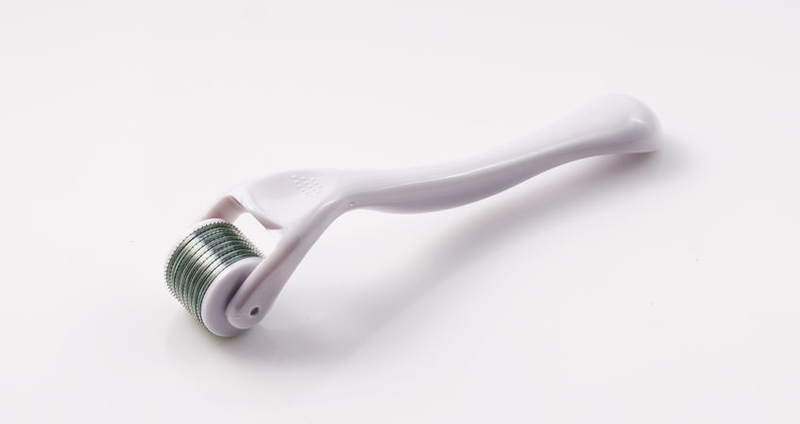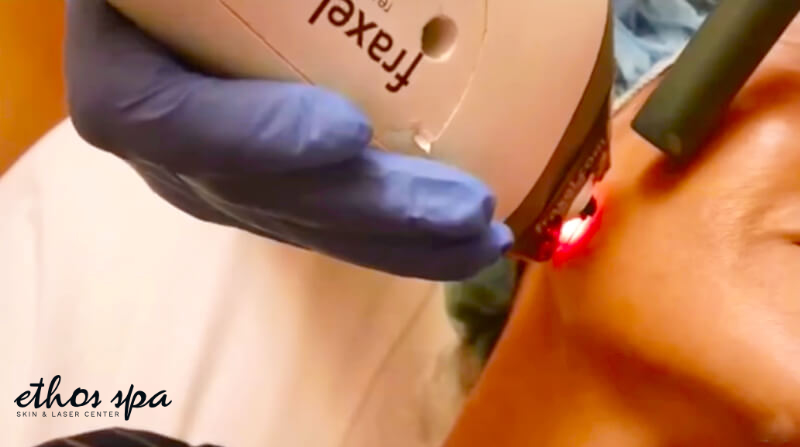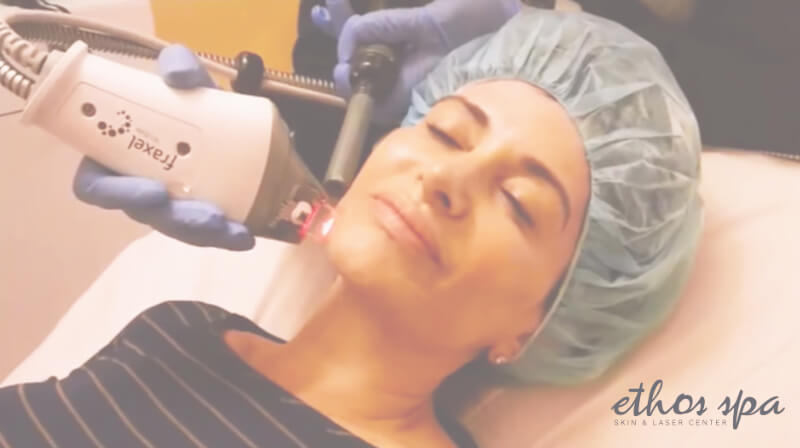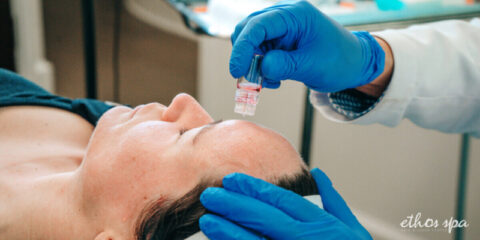Your skin deserves only the best. When you finally decide that it’s time to say goodbye to your acne scars, wrinkled skin, age spots, or any other facial skin issue, it’s in your best interest to make sure your skin gets only the best treatment available. And in the world of cosmetic facial treatments, two procedures stand out: Fraxel laser and microneedling.
So what is the difference between Fraxel laser and microneedling? Both procedures inflict micro-injuries on the patients, forcing the body to produce collagen, a skin-repairing protein. Fraxel fractional lasers penetrate the skin more deeply than microneedling, making the Fraxel treatment better suited for patients with major skin issues and microneedling better for mild skin issues.
What are Fraxel Laser and Microneedling Used For?
Fraxel and microneedling are similar types of procedures, which is why patients generally have to choose between one or the other. These two procedures are both used to improve the texture and tone of the skin when it has become damaged.
These procedures are ideal for both men and women between the ages of 25 and 60 who seek to treat the following:
- Fine lines
- Acne scars
- Texture issues
- Traumatic scars, including injuries, burns, and surgical scars
- Age spots, brown sunspots, and any uneven skin tone
- Stretch marks
Microneedling is an older and more traditional procedure, with cases of dermatologists administering it on patients dating back to the early 1900s. Fraxel fractional laser, however, is more recent and advanced, with first uses of non-surgical lasers for general facial rejuvenation occurring in 2000.
What Causes Skin Damage?
Millions of people suffer skin damage, with thousands suffering it to an extent that they require significant treatments such as microneedling and Fraxel. So what are the most common causes of skin damage?
- Excessive exposure to the sun: The sun’s ultraviolet rays break down the skin’s natural collagen and elasticity, allowing for the quickened development of brown spots, age spots, and wrinkles
- Alcohol and cigarettes: Alcohol leads to general body dehydration; dehydrated skin ages quicker, leading to wrinkles and loss of elasticity. Cigarette smoke leads to constricted blood vessels, leading to a lack of nutrition and oxygen for your skin
- Chemical irritants: Laundry detergent, cleaning products, and other chemical household items can lead to skin irritation. Repeated irritation leads to long-term skin damage and pigmentation changes
- Unhealthy diet: Having a bad diet is one of the most common reasons for unhealthy skin. Less vitamins and nutrients in the body leads to a weaker immune system, leading to general dry skin more prone to skin damage
- Face strain: Muscle strain on your face with excessive facial expressions can lead to wrinkling and fine lines
Understanding Microneedling

The Science Behind Microneedling
Microneedling is a minimally invasive procedure that uses a dermaroller with tiny needles. Also referred to as collagen induction therapy, microneedling is most often used to treat stretch marks and acne scars. It is also used in conjunction with other anti-aging procedures, such as sun spot treatment and eyelid surgery.
Microneedling works by forcing the skin to produce additional collagen, which is the body’s most abundant protein that leads to the redevelopment of new cells. Microneedling increases collagen production by injuring the skin with the dermaroller, which has hundreds of tiny needles.
The skin is pricked at a superficial level, meaning no real damage is done to the patient, but just enough damage is done to start collagen generation. The new collagen repairs the skin, replacing the previously damaged skin with new skin.
The Microneedling Process
After consultation, the microneedling doctor asks the patient to lie down or sit. A small pen-like tool known as a dermaroller is then applied to the skin. Small pricks are made to the skin by the dermaroller; while there may be slight pain, the patient should be relatively unharmed and relaxed during the procedure.
To decrease any pain, the doctor may apply a topical anesthetic to the skin prior to the procedure. The procedure should take about 30 minutes to an hour, depending on how much of the face is treated.
Microneedling Risks / Side Effects
Side effects or risks of microneedling include:
- Bleeding
- Irritation
- Peeling
- Infection
- Bruising
Patients who fall under the following should not be considered for microneedling:
- Pregnant
- Easily scar
- Have open wounds
- Have skin diseases such as eczema or psoriasis
Microneedling Results
Recovery time for microneedling is minimal since it is a minimally invasive procedure. In most cases, patients may expect no recovery time at all and also should be able to get back to their normal routines immediately after the procedure.
Skin rejuvenation starts as soon as the procedure is done, but patients should expect to wait several weeks before seeing best results. Multiple sessions of microneedling, as well as other treatments to increase its effectiveness, should be expected for best results.
Understanding Fraxel Laser

The Science Behind Fraxel Laser
Fraxel is a type of microscopic non-invasive procedure that encourages elastin and collagen growth through skin penetration, similar to microneedling. A type of fractional skin resurfacing treatment, Fraxel only focuses on a fraction of the targeted treatment area at a time.
The common Fraxel treatment is the Fraxel Dual, which uses two different wavelengths to address texture issues and discoloration issues. With these wavelengths, Fraxel laser treatment creates tiny micro-injuries on the skin, creating a specific grid pattern from the fractional lasers.
Unlike microneedling, Fraxel laser treatments penetrate the skin at a deeper level. There are two kinds of fractional resurfacing with Fraxel laser treatments: ablative and non-ablative. Ablative laser treatments are more aggressive, requiring longer recovery and downtime and creating more significant results.
The Fraxel Laser Process
The procedure begins with the doctor’s team numbing the skin; for extreme cases of skin resurfacing, the patient has the option to be sedated.
During the procedure, the lasers are beamed directly at the skin. These lasers destroy the epidermis, or the most outer layer of the skin with micro-injuries. While this is happening, the second layer of the skin, the dermis, is also heated up, leading to increased collagen production. This treatment can last up to 2 hours depending on the size of the treatment area.
Fraxel Laser Risks / Side Effects
Risks and side effects of Fraxel laser resurfacing include:
- Redness, itching, and swelling
- Slight risk of permanent scarring
- Pigmentation changes in patients with darker skin tones
- Slight risk of infection
- Messing with your skin during recovery can lead to slight acne
Fraxel Laser Results
The recovery process after a Fraxel treatment can be unnerving to some patients. The skin will be left intensely swollen and red immediately after the procedure, with countless micro-injuries spread across the face.
The skin recovers slowly over the next 10 days, however results will continuously improve over the next few weeks. Patients should expect to see dramatically improved skin after a successful Fraxel treatment.
Which Treatment Works Better: Microneedling VS Fraxel Laser Resurfacing
Patients can expect to see results with either treatment, microneedling or Fraxel laser resurfacing. However, as the Fraxel laser technique penetrates the skin at a deeper level, it is better suited for patients who have more serious skin problems, whereas microneedling is better suited for patients experiencing light to mild problems.
On its own, Fraxel laser is a much more effective treatment for patients looking for dramatic skin rejuvenation results. Microneedling is often partnered with another treatment or a series of cosmetic treatments to create an overall improved appearance.
Treat Your Look With New Jersey’s Premier Skin and Laser Center: Ethos Spa
If you are interested in learning more about microneedling, Fraxel laser, or any other type of skin and laser cosmetic procedure, contact or visit us at Ethos Spa today. We are the premier provider of skin and laser cosmetic treatments in the New Jersey area and have helped thousands of patients reach their physical potential.
Book your appointment and get 10% off your first visit!



